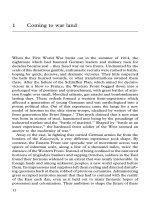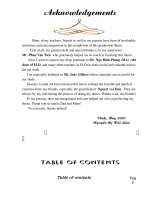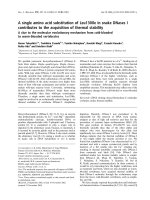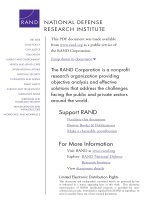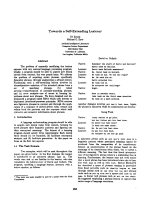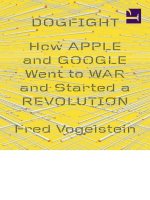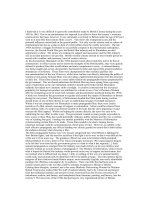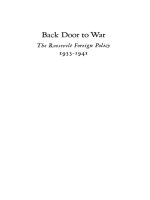Farewell to war
Bạn đang xem bản rút gọn của tài liệu. Xem và tải ngay bản đầy đủ của tài liệu tại đây (293.55 KB, 43 trang )
9
Farewell to war?
Warinthelegalsensehasbeeninlargemeasure‘outlawed’;thatis, ...
international law ... no longer recognizes that large-scale hostilities may
constitute a ‘state of war’ in which the belligerents are legally equal.
Quincy Wright
1
Banished as a legal institution, war now remains an event calling for legal
regulation for the sake of humanity and the dignity of man.
Hersch Lauterpacht
2
Never was there a more moralistic conflict than the Second World War. As
a contest between Good and Evil, it was seen to be at the furthest possible
remove from the positivist conception of war of the nineteenth century,
with its amoral focus on clashes between parochial state interests. In
1939–45, humankind itself was the cause. With the spirit of righteousness
as heavy in the air as the stench of corpses, it was hardly surprising that
just-war ideals should strongly pervade the immediate post-war era. And
this time, the task would be far more thoroughly done than in the interwar
period. The drafters of the United Nations Charter sought to go beyond the
League Covenant and the Pact of Paris, by banning all resorts to armed
force and thereby effacing the legal distinction between war and measures
short of war. The result was the establishment of a thoroughgoing general
norm of pacifism in international relations, directly reminiscent of the
pacifistic vision of the early Christian era which had lain at the heart of
medieval just-war doctrine.
The UN regime duplicated the earlier just-war vision in another
important way too: by spelling out the exceptional circumstances in
which resorts to armed force would be allowed. There were two such
1
Wright, ‘Outlawry’, at 365.
2
H. Lauterpacht, ‘Limits’, at 240.
314
situations. One was self-defence for cases of emergency action against
aggression. But the primary situation in which armed force would be
justified was community law-enforcement action, by the UN itself. In
the early post-war years, a number of international lawyers expressed a
warm approval of these new arrangements, sometimes making express
comparisons with the older medieval just-war ethos. The Colombian
lawyer J. M. Yepes, for example, openly welcomed ‘a renaissance of this
notion of the bellum justum which played a great role in the creation of
international law’.
3
In the same spirit, some lawyers rushed to proclaim
that, by implication if not expressly, the UN Charter brought about
the abolition of war in its nineteenth-century sense, as an honoured
institution of international law.
Events on the world stage failed, in substantial part, to fulfil these
bracing promises. Even if war was no longer a legal institution in
the nineteenth-century fashion, most – if not necessarily quite all – of
the individual elements of that package managed to survive in other
legal guises. What the world really witnessed after 1945 was less the
abolition of war than its reconceptualisation. The pieces of the puzzle, so
to speak, remained in existence; but they were assembled into somewhat
different patterns or pictures. This process of reconceptualisation or
reassembly came about largely as a result of two major factors, both of
them so far-reaching as justly to merit the label of ‘revolution’. One was
the ‘self-defence revolution’ (as it will be termed). It marked the full
emergence of self-defence to the front and centre of the international
stage, as a kind of all-purpose justification for unilateral resorts to armed
force. The other major factor undermining the abolition of war was what
will be termed the ‘humanitarian revolution’. This was a seismic shift in
fundamental conceptions of the laws on the conduct of armed conflict:
away from a focus on fairness and mutuality as between the warring states,
to a primary concern with relieving the suffering of victims of war.
There was a certain division of labour, as it might be termed, between
these two revolutions. The self-defence revolution was principally
addressed to the question of justifications for resorting to armed force
(the jus ad bellum in legal argot). The humanitarian revolution was
chiefly concerned with issues relating to the conduct of hostilities (the
jus in bello, in legal-ese). In all events, the ironic effect of these two
changes, in combination, was to bring about a conception of armed
conflict bearing a remarkable resemblance to the objective theory of war
3
47(1) Annuaire (1957), at 597. See also Yepes, Philosophie, at 44–8.
FAREWELL TO WAR
? 315
of the nineteenth century. Its thesis was that the outbreak of de facto
armed conflict between two states, whatever the circumstances and
whatever the legal justifications, automatically gave rise to a certain
predictable range of legal consequences. As in the old objective theory,
there was no urgency about attaching the specific label ‘state of war’ to
the situation. The important point was the practical one of ensuring that
the legal rules attaching to situations of armed conflict were duly
applied. This seemed a pragmatic, if not very idealistic, way of stripping
war of its legitimacy while continuing the effort to regulate it and to
moderate its horrors. There continued to be doubts, though, as to
whether the idea of a state of war could really be altogether dispensed
with. Suspicions remained that the traditional state of war may have had
certain potentially useful features that the pragmatic picture of war as de
facto armed conflict failed adequately to capture.
A neo-just-war order
It is not possible to give anything like a detailed account of the UN
system.
4
Instead, our task will be to point out the manner in which the
UN Charter marked a forthright turning away from nineteenth-century
positivist conceptions of war, in favour of a return to a just-war con-
ception of international relations in general and of war and peace in
particular. Very clearly present in the UN Charter system were the two
fundamental elements of a generic just-war system. First was the thesis
that the normal or residual condition of international relations was one
of peace. This was directly contrary to the Hobbesian outlook that
underlay the positivist view, in which competition and conflict were
seen as the basic features of global affairs. The second element was the
exposition of the conditions under which, exceptionally, armed force
would be justified. These were two in number. First was armed enforce-
ment action by the UN itself to defeat aggressors. This was, of course,
war in the manner of the Second World War, when Britain and France
leapt gallantly (if ineffectually) to the aid of Poland when it was attacked.
The other kind of just war was of a very much lesser stature. This was
self-defence, now expressly enshrined in the text of the UN Charter
itself. This was designed to be merely a stop-gap measure, pending the
4
Adam Roberts and Benedict Kingsbury (eds.), United Nations, Divided World: The UN’s
Roles in International Relations (2nd edn, Oxford: Clarendon Press, 1993), may be usefully
consulted for this purpose.
316
WAR AND THE LAW OF NATIONS
mobilisation of community enforcement by the UN. A key point is that
neither of these types of just war was a war in the nineteenth-century
positivist sense because neither of them consisted of an attempt by a
single state to bend another one to its will.
Banning the use of force
The basic prohibition against war in the post-1945 neo-just-war order was
set out in Article 2(4) of the UN Charter, which read simply as follows: ‘All
Members shall refrain in their international relations from the threat or use
of force against the territorial integrity or political independence of any
state, or in any other manner inconsistent with the Purposes of the United
Nations’.
5
In a certain sense, this provision signified a rejection of the
Hobbesian view of international relations as being inherently competitive
and war-riven. When compared to medieval just-war doctrine, however,
Article 2(4) of the UN Charter was a thin brew indeed. It was simply a rule
prohibiting force, with no indication that that rule has deep roots in any
comprehensive and widely shared view of human social relations in general,
as was the case in the Middle Ages. In that era, the pacifist outlook had been
powerfully embedded in an elaborate and detailed corpus of natural-law
thought, bolstered by an equally elaborate body of Christian doctrine. In
the post-1945 world, there was no such rich and detailed doctrine under-
pinning the norm of world peace. This was due in large part of course to the
high degree of religious and cultural heterogeneity of the global scene, as
compared to that of Christian Europe in the Middle Ages. As a result, the
rule on the non-use of force was something more in the nature of a pious
hope, based on the recent searing experience of two world wars, than of a
deep-rooted and widely shared value. The UN Charter, in short, was
drafted by lawyers and statesmen, not by doctrinaire pacifists. It was an
urgent response to local and immediate demands and conditions rather
than an expression of eternal verities.
It is not possible to undertake any extensive analysis of the meaning of
this basic UN Charter prohibition against the use of force. But a couple
of its most salient features are worth noting very briefly. For one thing, it
has become clear, largely as a result of a World Court case brought by
Nicaragua against the United States in 1986, that ‘force’, as used in the
5
The World Court has held that this ban on force is not simply a treaty rule binding UN
member states, but also a general rule of customary law. Nicaragua v. USA, 1986 ICJ Rep.
14, para. 188 (hereinafter ‘Nicaragua v. USA’).
FAREWELL TO WAR
? 317
Charter provision, has a broader meaning than the obvious one of
mounting a direct invasion of another country. The ban on the use of
force also encompassed such indirect measures as the supplying of an
insurgent force in another country with weaponry, training, intelligence
and the like, in conjunction with such measures as the mining of ports. It
may be noted, though, that a supply of financial assistance to an insur-
gent group does not constitute a use of force.
6
Further elaboration in
this area will be required in the future, but at least a start had been made
by the end of the twentieth century.
It may also be noted that, although Article 2(4) did not expressly state
that measures short of war, such as forcible reprisals, were within the
scope of the ban, there was a broad consensus amongst lawyers that they
were. The UN Security Council, for example, in 1964, stated forcible
reprisals to be a violation of the Charter.
7
The UN General Assembly
endorsed that position in 1970.
8
More importantly from the legal
standpoint, judicial support was provided by the World Court in the
Nicaragua v. United States case of 1986, and again in 1996, when it
handed down an advisory opinion on nuclear weapons.
9
Scholarly
commentary has been to the same effect.
10
If this position is the correct
one, then the UN Charter succeeded, at one fell swoop, in eliminating
the legal relevance of the distinction between wars and forcible reprisals,
which had so bedevilled lawyers in the interwar period. It is only
necessary to note, in passing, that the UN Charter tamed reprisals (so
to speak); but it did not completely ban them. Reprisals – rechristened as
‘countermeasures’ in the post-1945 period – remained permissible so
long as they took a non-forcible form, such as an economic boycott or
the suspension of performance of a treaty obligation.
11
Perhaps the most important point of all about the UN Charter’s ban
on the use of force, for present purposes, is the widespread, if largely
tacit, agreement that a resort to force in violation of the ban does not
6
Nicaragua v. USA, paras. 92–116.
7
SC Res. 188 (9 Apr. 1964), 19 SCOR, Res and Dec, at 9.
8
Declaration on the Principles of International Law Concerning Friendly Relations and
Cooperation among States, GA Res. 2625, 25 UN GAOR, Supp. No. 28, UN Doc. A/8028,
at 121; reprinted in 65 AJIL 243–51 (1971) (hereinafter ‘Declaration on Friendly Relations’).
9
Nicaragua v. USA, paras. 188–91; and The Legality of the Threat or Use of Nuclear
Weapons, 1996 ICJ Rep. 225, para. 46.
10
See, for example, Partsch, ‘Reprisals’, in 4 Encyclopaedia of Public International Law, ed.
Rudolf Bernhardt (Amsterdam: North-Holland, 2000), at 202.
11
See Omer Yousif Elagab, The Legality of Non-forcible Counter-measures in International
Law (Oxford: Clarendon Press, 1988).
318
WAR AND THE LAW OF NATIONS
constitute a war, but rather (in effect) an unlawful act of aggression
committed in peacetime. If the country that was attacked responded by
exercising its right of self-defence in the narrow sense (i.e., by fending off
the attack but going no further than that), then the situation would be a
case of aggression-and-self-defence – but still not a war. If the victim
country responded by going further than the law of narrow self-defence
allowed – by, say, repelling the attack and then carrying the conflict
into the aggressor’s home territory (as was done by Iran during the
Iran–Iraq conflict in the 1980s), then there was room for debate as to
whether the struggle would be a war, a matter that will be considered in
due course. For the present, it is only necessary to take brief note of the
legal consequences that would flow from a violation of the UN Charter’s
ban on the use of force. There were five such consequences. Three of
them were familiar from the general international law of the interwar
period, and two of them were new. A rapid survey will serve to fix them
in mind. The three familiar consequences may be recalled initially.
The first consequence of resorting to force unlawfully was liability to pay
compensation for all damage resulting from the wrongdoing.
12
On several
occasions in the post-1945 period, this principle was actually applied.
The first one was in the 1980s, when Nicaragua successfully claimed in
the World Court that the United States’ provision of large-scale assistance
to insurgents based in neighbouring Honduras amounted to a violation
of the ban against the use of force.
13
Nicaragua estimated its damages at
$370.2 million, although, in the event, it withdrew its claim before the
damages were actually assessed by the Court.
14
Where Nicaragua led, other
countries followed, though not always so successfully. In 1999, the Federal
Republic of Yugoslavia (FRY) brought legal actions in the World Court
against ten NATO states for the bombing attacks in connection with the
Kosovo crisis of that year. The Congo filed claims in the World Court
against Uganda in 1999 and against Rwanda in 2002 for alleged armed
interventions by those states in civil strife that was raging in the Congo.
(Uganda then counterclaimed against the Congo.) At the end of 2003, these
cases were still pending before the Court. In one especially striking case,
12
See Q. Wright, ‘Outlawry’, at 372–3; Brownlie, Use of Force, at 147–9; and Baxter, ‘Legal
Consequences’.
13
Nicaragua v. USA, paras. 227–8. Strictly speaking, the United States was held to have
violated not the UN Charter but rather the customary-law rule to the same effect. In
substance, though, this was fully equivalent to a violation of the Charter provision.
14
The claim was withdrawn in the wake of the election of a pro-American government in
Nicaragua, replacing the one that had instituted the suit.
FAREWELL TO WAR
? 319
compensation was actually paid for unlawful aggression, even if far from
gracefully. This was by Iraq to the various victims of its takeover and
occupation of Kuwait in 1990–1. In this case, compensation came about
not from judicial action but rather at the hands of the UN Security Council,
in the wake of the forcible expulsion of Iraq from Kuwait.
15
The assessment
and distribution of the sums of money were undertaken by an adminis-
trative body called the UN Compensation Commission, with the necessary
funds coming from the proceeds of Iraqi oil sales. By May 2004, some $48
billion worth of awards had been made (and nearly $18 billion actually
distributed), not only to Kuwait but also to a host of other parties, includ-
ing private individuals, who had suffered losses from the takeover.
16
A second consequence of violating the general ban on the use of force
was of the utmost importance: that third states might refrain, as a matter
of reprisal, from applying the law of neutrality and instead give overt
support to the victim country.
17
Herein lay perhaps the most significant
difference between a war and a case of aggression-and-self-defence: that
a war activates the law of neutrality, thereby making impartiality man-
datory on the part of third parties; while aggression-and-self-defence
situations allow third parties to be partial (towards the victim state, of
course). Some even went so far as to hold partiality to be required rather
than merely permitted.
18
Be that as it may, third parties are allowed, at a
minimum, to be partial to victims of aggression, in the manner of the
American ‘non-belligerency’ policy of 1939–41, without incurring legal
liability for violation of the law of neutrality.
19
The effect is that third
states can supply, say, armaments or funding to victim countries. This
principle is of especial importance because, by its nature, it operates
during the hostilities and thereby potentially makes a direct material
contribution to the defeat of the aggressive enterprise.
15
See SC Res. 692 (20 May 1991), 46 SCOR, Res and Dec, at 18.
16
By ‘billion’ is meant 1,000 million (as in American usage). To track the activities of the UN
Compensation Commission, see www.unog.ch/uncc. The discrepancy between awards
made and funds distributed was chiefly the result of discrepancies in three categories of
claims: oil-sector corporate claims, Kuwait government claims, and government claims
for environmental damage. On the Commission, see Rattalma, ‘Re
´
gime de responsabilite
´
’.
17
It should always be remembered that the UN Charter only banned forcible reprisals,
leaving non-forcible countermeasures, such as the non-performance of normal legal
obligations, in place.
18
See, for example, E. Lauterpacht, ‘Legal Irrelevance’, at 64–5.
19
See, to this effect, the Harvard Research draft Convention on the Rights and Duties of
States in Case of Aggression, 33 (Supp.) AJIL 827 (1939), Art. 12.
320
WAR AND THE LAW OF NATIONS
A third consequence of aggression was that any gains made by means
of an unlawful use of force would not be accorded recognition by the
international community. This was, of course, the essence of the
Stimson Doctrine of 1932. It was expressly endorsed by the UN
General Assembly in 1970, which confirmed that ‘[n]o territorial acqui-
sition resulting from the threat or use of force shall be recognised as
legal’.
20
A notable application of this doctrine occurred in the wake of
the effective takeover of Cambodia by Vietnam in 1979, with the instal-
lation of a puppet government (comparable to that of Manchukuo in the
1930s). The UN responded by refusing to accept the Vietnam-installed
rulers as the true government of Cambodia. In this same vein, there was
also universal agreement that any treaty brought about by means of an
unlawful use of force would be, legally, a complete nullity.
21
Stated in its
most general form – which, however, has not as yet received judicial
endorsement – the principle would be that an unlawful use of force
could not be the source of legal rights of any description whatever.
These three effects of an unlawful resort to force were familiar, in
doctrine if not always in practice, from the interwar period and even
earlier. After 1945, however, there were two further legal consequences
of an unlawful use of force to be taken into account. The first one was the
possibility of criminal prosecutions, before an international tribunal, of
the individuals who were responsible for planning and executing the
aggression.
22
In the Charter of the International Military Tribunal,
which presided over the Nuremberg Trials of 1946, this offence was
given the label of ‘crimes against the peace’.
23
Sixteen defendants were
charged with it at Nuremberg, of whom twelve were convicted (and
seven sentenced to death by hanging).
24
In similar post-War trials in
20
Declaration on Friendly Relations.
21
Vienna Convention on the Law of Treaties, 23 May 1969, 1155 UNTS 331, Art. 52. On the
Stimson Doctrine in UN practice, see John Dugard, Recognition and the United Nations
(Cambridge: Grotius, 1987), at 27–35. On the non-recognition principle generally, see
Brownlie, Use of Force, at 410–23.
22
It will be recalled that the Versailles Treaty had provided for the prosecution of Kaiser
William II of Germany after the First World War. The offence envisaged, though, was
violation of treaties, rather than the breach of any general rule against the use of force.
Such a rule did not exist at that time.
23
Charter of the International Military Tribunal, 8 Aug. 1945, 82 UNTS 279, Art. 6.
24
In re Goering, Int’l Military Tribunal, 1 Oct. 1946, 13 ILR 203. On the Nuremberg Trials,
see generally Bradley F. Smith, Reaching Judgment at Nuremberg (London: Andre
´
Deutsch,
1977); Ann Tusa and John Tusa, The Nuremberg Trial (London: Macmillan, 1983); and
Telford Taylor, The Anatomy of the Nuremberg Trials: A Personal Memoir (Boston: Little,
Brown, 1992).
FAREWELL TO WAR
? 321
Tokyo, twenty-two Japanese figures were found guilty of this offence
(seven of whom were sentenced to death).
25
Since that time, there have
been no further international prosecutions under this heading.
26
The
major stumbling block to further action in this area was the inability of
lawyers and statesmen to craft a definition of ‘aggression’ that was
sufficiently precise for use in criminal prosecutions.
27
In 1998, however,
provision was made for possible further trials of this kind by a newly
created International Criminal Court. Aggression was one of the crimes
covered by the Court’s Statute, although that provision could not take
effect until a definition of ‘aggression’ could be agreed.
28
On this point
of criminal prosecutions, it only remains to note that the crime
of aggression was reserved for the planners of aggressive war, not for
the ordinary soldiers who were merely the instruments of it. A soldier
fighting an aggressive war was only liable to prosecution if he committed
some specific violation of the laws on the conduct of war.
29
The final consequence of an unlawful resort to force was the possibil-
ity of armed action by the international community at large under the
auspices of the UN Security Council. This was a just war in the fullest
sense of that term. As such, it calls for some slightly fuller exploration.
The new just wars – UN enforcement action
The League of Nations Covenant could hardly be said to have had any
conception of just wars in any true sense – meaning wars undertaken for
the enforcement of community norms against wrongdoers. As observed
earlier, the Covenant was, in essence, a war prevention device, employ-
ing peaceful-settlement obligations and cooling-off periods – but with
25
In re Hirota, Int’l Military Tribunal for the Far East, 12 Nov. 1948, 15 ILR 356. In the
Tokyo trials, two other defendants were found guilty of conspiring to wage aggressive war,
though not of actually waging it. On the Tokyo trials, see generally Arnold C. Brackman,
The Other Nuremberg: The Untold Story of the Tokyo War Crimes Trials (London: Collins,
1989).
26
The international criminal tribunals established in the 1990s in the wake of crises in
Yugoslavia and Rwanda did not have crimes against the peace (or aggression) within their
jurisdiction.
27
For a purported, but in fact largely ersatz, definition of aggression by the UN General
Assembly in 1974, see GA Res. 3314 (XXIX), 39 GAOR, Supp. No. 31, at 142. For a
thorough study of the problem, see Rifaat, International Aggression.
28
Statute of the International Criminal Court (Rome Statute), 17 July 1998, UN Doc.
A/CONF/183/9, Art. 5(2). Agreement on this point was still awaited at the end of 2003.
29
In re von Leeb (High Command Case), US Military Tribunal at Nuremberg, 28 Oct. 1948,
15 ILR 376, at 381–3. On aggressive war as a crime, see Dinstein, War, at 106–34.
322
WAR AND THE LAW OF NATIONS
no change in the underlying conception of war as inherited from the
nineteenth century. War, when it occurred, was still seen as a clash of
rival state interests, having no higher legal or moral significance. The
nearest that the Covenant came to a community policing measure was
its provision for economic sanctions against states unlawfully resorting
to war, fortified (as they might be in special cases) by a naval blockade.
30
The position under the UN Charter presented the starkest contrast. The
Security Council, unlike the Council of the League of Nations, was
entrusted with the power not only to impose mandatory economic
sanctions against aggressor states but also to take up arms itself, on
behalf of the global community, to subdue aggression on the field of
battle. Ideally, swords would be beaten into ploughshares; but pending
this happy development, the UN Security Council was to stand ever
ready to play the role of the medieval church militant when the need
arose.
It is unnecessary to embark upon a detailed exposition or history of
UN enforcement.
31
But certain features of it that bear on the fate of war
after 1945 should be pointed out. One is that UN enforcement was not
regarded as war. That is to say, it was not seen as creating a state of war.
This point was reflected in the terminology employed, with such labels
as ‘police action’ or ‘enforcement action’ being common. The term
‘intervention’ – used in its nineteenth-century sense – might have
been appropriate, although after 1945 that expression came to be
regarded as a pejorative one.
The UN scheme was, however, in many ways, more reminiscent of the
nineteenth-century Concert of Europe system than of medieval just
wars. This was chiefly because the UN system, like the Concert of
Europe, was more political than legal in nature. Where medieval just-
war doctrine had stressed the need for a justa causa in the strict legal
sense, the UN Security Council, like the Concert of Europe before it,
addressed itself chiefly to dangerous or destabilising political situations.
In the words of the UN Charter, the Security Council was empowered to
take action against a ‘threat to the peace, breach of the peace or act of
aggression’ rather than against violations of international law per se.
32
The UN Security Council was, admittedly, a somewhat more democratic
arrangement than the Concert of Europe had been, in that the Council
30
See Chapter 8 above.
31
For a brief survey of the UN’s experience, see Franck, Recourse to Force, at 20–44.
32
UN Charter, Art. 39.
FAREWELL TO WAR
? 323
comprised not merely the five major powers (the United States, the
Soviet Union, Britain, France and China) as permanent members but
also ten other countries chosen by a vote of the UN General Assembly to
serve two-year terms. But the major powers, with permanent member-
ship and the power of veto, held strongly dominant positions.
In the post-1945 period, relations amongst the major powers were,
however, far from harmonious. Cold-War rivalries and other political
considerations prevented the UN enforcement system from functioning
in anything resembling the manner originally hoped. Plans for the
creation of a standing UN military capacity, for example, came to
nothing, largely because of sharp differences of view between the
United States and the Soviet Union over the arrangements.
33
Also, the
possession of a veto power in the Security Council by each of the five
permanent powers came close to preventing effective UN enforcement
activity altogether. By the end of the twentieth century, there were only
three major instances in which the Security Council authorised armed
force. The first was the Korean conflict of 1950–3, when the Council was
able to act only by virtue of the absence of the Soviet Union from the
sessions in which the key decisions were made.
34
The other two instances
both took place after the Cold War had ended: the liberation of Kuwait
from Iraq in 1991 and the expulsion of an unconstitutional military
government in Haı
¨
ti in 1994.
35
It is important to note that UN enforcement action, like medieval
just wars, differed significantly from self-defence action in the narrow
sense of merely fending off a blow. Indeed, there was no requirement in
the UN Charter that enforcement action be defensive. The case of UN
action in Korea in 1950–3 illustrates the point. In its earliest stages, the
UN action was necessarily defensive, since the immediate task was to
repel a massive invasion of South Korea by North Korean forces. The
UN-supported side did not, however, rest content with expelling North
Korean troops from the South, but went on to mount a large-scale
military invasion of North Korea itself with a view to bringing about
a complete resolution of the political situation in the Korean peninsula.
The legal basis for this expansion of the conflict was found in the
33
See 1 Evan Luard, A History of the United Nations: The Years of Western Domination,
1945–1955 (London: Macmillan, 1982), at 98–105.
34
See SC Res. 83, (27 June 1950), 5 SCOR, Res and Dec, at 5.
35
See SC Res. 678 (29 Nov. 1990), 45 SCOR, Res and Dec, at 27 (on Kuwait); and SC Res. 940
(31 July 1994), 49 SCOR, Res and Dec, at 51 (on Haı
¨
ti). Enforcement action against
Southern Rhodesia in 1966–79 comprised only economic sanctions and not armed force.
324
WAR AND THE LAW OF NATIONS
Security Council resolution of June 1950, which had authorised UN
member states not merely to repel the North Korean invasion but also
‘to restore peace and security to the area’.
36
(In the event, carrying
the conflict northward had the unintended and unwelcome effect of
bringing China into the fray on North Korea’s side.) The Gulf conflict
of 1991 was different, in that the military action itself stopped after
the liberation of Kuwait. It may be noted, though, that the peace
arrangements, as set out in a Security Council resolution in April
1991, went beyond the bounds of narrow self-defence by imposing a
number of conditions on Iraq designed to prevent future misconduct.
37
The most notable of these were disarmament obligations, with inter-
national inspection to ensure compliance. Furthest of all from self-
defence in the narrow sense – or even from defensive action in any
sense – was the case of Haı
¨
ti in 1994, in which there was no pretence of
any aggression or threat of aggression by that country against any other
state. Haı
¨
ti’s only offence was to have a government constituted in a
manner unacceptable to the world at large.
Finally, it may be noted that, in the matter of neutrality, the UN just-
war scheme also echoed its medieval ancestor. Both saw neutrality as
incompatible in principle with a just-war system, just as, in domestic
societies, neutrality between law enforcement and crime is commonly
regarded as incompatible with good citizenship and devotion to the rule
of law. Indeed, the UN scheme outdid its predecessor on this count by
instituting what amounted to an express prohibition against neutrality
in UN enforcement operations. Article 2(5) of the Charter required UN
member states to ‘give the United Nations every assistance’ in cases of
preventive or enforcement action. In short, UN member states were
obligated to adopt policies of ‘non-belligerency’ in cases of UN enforce-
ment action, along the lines pioneered by the United States in 1939–41.
Pursuant to this provision, a number of traditionally neutral states, such
as Sweden, Austria and Ireland, indicated their support for the UN side
in the Korean and Kuwait conflicts and provided various forms of non-
military support, such as allowing overflight rights to the UN-supported
side.
38
36
SC Res. 83 (27 June 1950), 5 SCOR, Res and Dec, at 5. On the American view of the legal
position, see Goodrich, Korea, at 126–8.
37
SC Res. 687 (3 Apr. 1991), 46 SCOR, Res and Dec, at 11.
38
Neff, Rights and Duties, at 193.
FAREWELL TO WAR
? 325
The new just wars – self-defence
The second category of just war in the post-1945 era was self-defence.
The two types of just war were not, however, of equal standing by any
stretch of the imagination. Community action by the UN as a whole had
a higher status than self-defence by individual states. The position here
was very distinctly reminiscent of the medieval just-war outlook, which
had looked upon self-help with dark suspicion, reserving its fullest
approval for altruistic action on behalf of the community at large. This
same ethos pervaded the UN Charter scheme. Self-defence was expressly
described in the Charter in a thoroughly medieval, natural-law manner
as an ‘inherent right’ of states, exercisable without auctoritas from any
superior body.
39
This reference to self-defence as an inherent right
clearly suggested that, as in classical natural-law doctrine, self-defence
was to be understood in its narrow sense of merely warding off a blow
that was in the course of being struck, a position that was confirmed by
the World Court in 1986.
40
Although, as just observed, self-defence was described as an inherent
right of states, the UN Charter added two features to the traditional
natural-law right: first, it added what was called a right of collective self-
defence, thereby allowing states assisting a victim of aggression to fall into
the category of ‘self’-defenders; and second, it imposed a duty onto self-
defending states to keep the UN Security Council informed of measures
that they were taking. The limited character of self-defence was clearly
apparent in the Charter’s explicit treatment of it as an interim measure,
permissible only ‘until the Security Council has taken measures necessary
to maintain international peace and security’.
41
Self-defence, therefore,
qualified as a just war only in a rather limited and provisional – even
quasi-apologetic – manner.
42
Nevertheless, for the first time in history,
self-defence was in the charmed circle of just wars, if only with very junior
status.
There was yet another respect in which self-defence may be viewed as,
in effect, only a quasi-just war. That is, that the distinction between
defence and offence, as in the Middle Ages, bore no necessary relation to
39
On the drafting history of this Charter provision, see Alexandrov, Self-defense, at 77–93;
and Franck, Recourse to Force, at 45–51.
40
Nicaragua v. USA, paras. 193–5.
41
UN Charter, Art. 51. On Article 51, see Bowett, Self-defence, at 182–99; Alexandrov, Self-
defense, at 93–105; and Gray, Use of Force, at 84–143.
42
See Kelsen, Principles, at 63–4; and Bowett, Self-defence, at 19–21.
326
WAR AND THE LAW OF NATIONS
the legal merits of an underlying dispute. In the UN system, an offensive
resort to force was (at least in principle) illegal per se,evenifthestate
taking up the sword had an impeccable legal case for its position (such
as, for example, clear legal title to territory occupied by another state).
UN enforcement action, in contrast, could take an offensive form, if the
Security Council held that to be necessary. Enforcement action, in other
words, in contrast to self-defence, was a true sanction. That is to say, it
was (at least potentially) a punitive weapon, which could be wielded
offensively against wrongdoers for past misdeeds, or preventively to stop
wrongdoing from occurring in the first place. Self-defence, at least in
principle, was stuck resolutely in the present tense, warding off attacks as
they were taking place.
There was, accordingly, a kind of division of labour between these
greater and lesser types of just war (as they might be termed). Self-
defence, as the lesser measure, operated only on an interim, emergency
basis for the strictly limited purpose of parrying an aggressor’s blow. UN
enforcement action, as the greater measure, could operate open-endedly
and offensively, at the sole discretion of the UN Security Council. Self-
defence, as a unilateral measure, dealt with the symptoms of aggression
(i.e., with the actual physical attack). UN enforcement action could deal
more broadly with underlying causes of world instability.
The division of labour between the two types of just war, however,
was inherently adjustable. The more prompt and effective the UN
Security was, the smaller a part would self-defence naturally play. But
theconversewasalsotrue.Theless active the UN Security Council was,
the greater would be the role left for self-defence. And in the event, the
Security Council, for decades after its inception, proved to be supremely
feckless, largely as a result of Cold-War rivalries between the major
powers. The result was to leave a gaping vacuum in the UN system – a
vacuum that was duly filled by a remorseless expansion of self-defence.
Where self-defence had originally been scripted to play only the most
modest of supporting roles in the great drama of just-war revival, it now
moved relentlessly – one could almost say imperialistically – to centre
stage, with the effect that it was transmuted from its original narrow
conception into a single all-purpose justification for armed force, play-
ing the part of the older categories of just war. This was the self-defence
revolution of the post-1945 era.
43
43
For a useful general survey of state practice on self-defence after 1945, see Alexandrov, Self-
defense, at 121–290.
FAREWELL TO WAR
? 327
To appreciate the full scope and significance of this post-1945 self-
defence revolution, it is well to recall just how narrow self-defence
originally was. In the canonical words of Webster in the Caroline affair,
universally quoted by lawyers, self-defence was reserved for threats that
were ‘instant, overwhelming, leaving no choice of means, and no
moment for deliberation’.
44
In the early UN period, even the most
powerful states hesitated to make too obvious a departure from this
strict standard. In the Suez crisis of 1956, for example, Britain and
France carefully refrained from relying exclusively on self-defence, por-
traying their military action primarily as a high-minded peacekeeping
intervention, to separate Israeli and Egyptian forces. R. A. Butler, the
British Lord Privy Seal, described it at one point as a ‘police action’.
45
(The British government tactfully refrained from informing the world
that it, along with the French government, had collaborated with Israel
to create the very hostilities which the intervention was designed to
halt.)
46
In the Cuban missile crisis of 1962, the United States also
pointedly refrained from using self-defence as the justification for its
‘quarantine’ policy, which entailed the halting and inspecting of foreign
ships on the high seas (and their diversion from Cuba if they were
carrying offensive missile equipment). The reason for this caution was
that there clearly had been no actual armed attack on the United States
(although there were palpable fears for the future). The United States
therefore justified its action as an enforcement measure authorised by
the Organisation of American States.
47
With the passage of time, however, qualms about invoking self-
defence were brought increasingly under control by states. Self-defence
claims blossomed so luxuriantly, and expanded in so many directions as
effectively to encompass any arguably justifiable resort to force. This
expansion – one could even say explosion – of self-defence claims after
1945 took place on various levels: in time, both backwards and forwards
from the actual attack; in space, to geographical locations far removed
44
Webster to Fox, 24 Apr. 1841, 26 BFSP, at 1137–8.
45
Remarks of Butler, Hansard, HC, vol. 558, ser. 5, col. 1726–7, 1 Nov. 1956. On views
within the British government as to the lawfulness of the armed action, see Marston,
‘Armed Intervention’.
46
See Keith Kyle, Suez (London: Weidenfeld and Nicolson, 1991), at 314–31.
47
For doubts as to the lawfulness of the American action in the Cuban crisis, see Quincy
Wright, ‘The Cuban Quarantine’, 57 AJIL 546–65 (1963). For the contention that self-
defence would have been a more appropriate justification, see Myres S. McDougal, ‘The
Soviet-Cuban Quarantine and Self-defense’, ibid. at 597–604.
328
WAR AND THE LAW OF NATIONS
from the attack; and in subject matter, beyond the protection of the
territorial integrity of the defending state.
Consider first the expansion on the temporal plane. In its original and
strict sense as an inherent natural-law right, self-defence in the narrow
sense had been very much a matter of (so to speak) the present tense.
That is to say, it did not include a right to use force either before
an attack as a preventive measure or afterwards, to counteract its con-
sequences. There was admittedly some leeway in this regard; but it was
very slight, allowing preemptive action when an aggressive blow was on
the very brink of being struck. The most notable example of this was
Israel’s attack on Egypt and other neighbouring Arab states in 1967.
48
With the passage of time, however, states came to take ever more
generous views of self-defence, holding preventive action to be increas-
ingly necessary – and hence lawful – in an age in which lightning-fast
delivery of nuclear weapons was all too foreseeable. The only effective
defence, some argued, against such a catastrophe was a steely willingness
to strike the enemy (or the enemy-to-be) in ever earlier stages of its
preparations.
The most striking claim of this nature was announced by the United
States in 2002, when it openly and officially adopted a preventive strat-
egy, at least against certain kinds of threats. In a statement of the
National Security Strategy of the United States of America, the
American government frankly announced a policy of resorting to pre-
ventive or defensive war. The United States, it was pronounced, could
not ‘remain idle while dangers gather’ or afford to ‘let our enemies strike
first’. ‘The greater the threat [maintained the United States], the greater
is the risk of inaction – and the more compelling the case for taking
anticipatory action to defend ourselves, even if uncertainty remains as to
thetimeandplaceoftheenemy’sattack.Toforestallorpreventsuch
hostile attacks by our adversaries, the United States will, if necessary, act
preemptively.’
49
Nor was it long before the United States found the
opportunity to put this principle into vigorous operation. In 2003, in
conjunction with Britain and Australia, it mounted an armed invasion
of Iraq, which led to the swift overthrow of its government, followed by a
military occupation of the country. One of the justifications given by the
48
See Franck, Recourse to Force, at 101–5.
49
‘US Adoption of New Doctrine on Use of Force’, 97 AJIL 203–5 (2003). On this ‘Bush
Doctrine’, as it has been labelled, see Walter LaFeber, ‘The Bush Doctrine’, 26 Diplomatic
History 543–58 (2002).
FAREWELL TO WAR
? 329
United States for the attack was the existence of a programme for the
production, and possible use, of weapons of mass destruction such as
chemical or biological, or even nuclear, armaments.
50
The operation,
however, soon turned into a vivid lesson in the risks of preventive action,
when evidence of such a programme failed to materialise. It was a dramatic
demonstration of the fact that, the more remote is the danger against which
action is taken, the more tentative must the assessment of the situation
necessarily be – a point recognised by Grotius and his followers centuries
earlier, when they earnestly condemned the waging of defensive war on the
basis of merely speculative future dangers.
51
The temporal growth of self-defence was apparent in the other direc-
tion too, as a justification for armed action after attacks had occurred
and been completed, thereby effectively reviving the second of Grotius’s
classic just causes of war: the obtaining of something that was owing.
The British recovery of the Falkland Islands in 1982, after their forcible
occupation by Argentina, was an apt illustration. Speaking in the very
strictest sense, it was not self-defence, since the takeover had been
completed. Instead, it was a recovery operation, a reversal of a fait
accompli. Nevertheless, Britain consistently invoked self-defence as the
legal justification for its action; and this was accepted by international
lawyers with little opposition.
52
Self-defence sometimes even had a backward and forward orientation
at the same time – performing the dual role of rectifying past wrongs and
preventing future ones. The result was sometimes to make it very
difficult to distinguish self-defence action from forcible reprisals.
53
In
recognition of the fineness of the line between the two, some scholars
advanced the view that ‘defensive reprisals’ were permissible under the
UN Charter, meaning actions taken after an attack had occurred, with a
view to preventing or discouraging future attacks (i.e., with a broadly
defensive purpose).
54
This contention did not meet with widespread
scholarly acceptance or judicial approval, but there were many instances
of it in state practice. It was especially a feature of Israeli policy, which
responded to guerrilla or terrorist attacks by armed action afterwards,
50
Britain, in contrast to the United States, was careful to base its legal justification on the
breach by Iraq of its obligations under various existing UN Security Council resolutions.
51
On the Iraq intervention and self-defence, see Sapiro, ‘Iraq’.
52
Statement of Biffen, 20 May 1982, in 53 Brit YB 519–20 (1982).
53
For the view that there was no fundamental difference between them, see Venezia, ‘Notion
de repre
´
sailles’.
54
See, notably, Dinstein, War, at 194–203.
330
WAR AND THE LAW OF NATIONS

